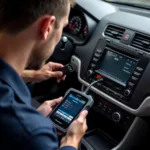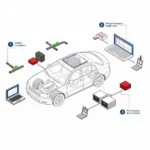Choosing the right diagnostic scan tool for Australian cars can be a daunting task, especially with so many options available in the market. Whether you’re a seasoned mechanic or a car enthusiast looking to DIY, having the right tool can save you time, money, and unnecessary headaches. This comprehensive guide will walk you through everything you need to know about diagnostic scan tools, helping you make an informed decision.
Understanding Diagnostic Scan Tools and Their Importance
Before we delve into the specifics, let’s first understand what diagnostic scan tools are and why they are essential.
In simple terms, a diagnostic scan tool is like a window into your car’s computer system. It allows you to communicate with the various electronic modules within your vehicle, reading and clearing fault codes, monitoring live data streams, and performing various tests.
With the increasing complexity of modern vehicles, diagnostic scan tools have become indispensable for:
- Accurate Diagnosis: Identifying the root cause of a problem quickly and efficiently.
- Cost Savings: Avoiding unnecessary repairs by pinpointing the exact issue.
- Improved Performance: Monitoring vital engine parameters and making adjustments for optimal performance.
- Enhanced Safety: Identifying potential safety concerns before they escalate.
Types of Diagnostic Scan Tools for Australian Cars
The Australian car market features a diverse range of vehicles, from locally manufactured models to popular imports. When choosing a diagnostic scan tool, it’s crucial to select one that caters to the specific makes and models you intend to work on.
Here are the most common types of diagnostic scan tools:
1. OBD2 Code Readers
These are basic scan tools that can read and clear generic fault codes (also known as DTCs or Diagnostic Trouble Codes) from a vehicle’s OBD2 port. They are generally affordable and suitable for basic diagnostics, such as checking engine-related issues.
2. Enhanced OBD2 Scanners
These tools offer more features than basic code readers, such as live data streaming, freeze frame data, and some bi-directional control capabilities. They are suitable for DIY enthusiasts and small workshops dealing with a wider range of diagnostics.
3. Professional-Grade Scan Tools
These are high-end tools used by professional mechanics and dealerships. They offer comprehensive coverage for various car makes and models, advanced programming and coding capabilities, and access to manufacturer-specific diagnostics.
Key Features to Consider for Australian Cars
When choosing a diagnostic scan tool for Australian cars, consider the following factors:
- Vehicle Coverage: Ensure the tool supports the specific makes and models you work on, including Australian-specific variants.
- Software Updates: Regular software updates are crucial for compatibility with the latest car models and diagnostic protocols.
- Ease of Use: The tool should have a user-friendly interface and intuitive navigation.
- Data Logging and Reporting: The ability to log and generate reports is essential for tracking repairs and providing documentation.
- Additional Features: Consider features like battery testing, ABS bleeding, and other specialized functions based on your needs.
Conclusion: Making the Right Investment
Investing in the right diagnostic scan tool is crucial for any mechanic or car enthusiast in Australia. By understanding the different types of tools available, considering key features, and focusing on your specific needs, you can make an informed decision that will pay dividends in the long run.
Remember, a reliable diagnostic scan tool empowers you to take control of your car’s health, saving you time, money, and frustration in the future.


